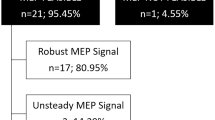Abstract
Purpose
The purpose of this study is to evaluate the possibility of d-wave recording in very young patients during spinal cord surgery.
Method
A 10-month-old patient was operated on cystic intramedullary pathology and myelon tethering at level cervical VI. to thoracal III. During the surgical detethering, we did d-wave recording for experimental purposes. After transcranial electric stimulation, we tried to detect the responses with epidural d-wave electrodes proximally and distally from the pathology.
Results
We found that proximally from the pathology, we could detect reproducible d-waves.
Conclusion
Though earlier papers reported that due to the immature condition of the myelon d-wave recording is not possible under the age of 21 months, we proved that even in very young patients, the possibility of d-wave recording should not be excluded.


Similar content being viewed by others
References
Costa P, Peretta P, Faccani G (2013) Relevance of intraoperative D wave in spine and spinal cord surgeries. Eur Spine J 22(4):840–848. doi:10.1007/s00586-012-2576-5
Deletis V, Sala F (2008) Intraoperative neurophysiological monitoring of the spinal cord during spinal cord and spine surgery: a review focus on the corticospinal tracts. Clin Neurophysiol 119(2):248–264
Epstein F, Epstein N (1982) Surgical treatment of spinal cord astrocytomas of childhood. A series of 19 patients. J Neurosurg 57(5):685–689
Epstein FJ, Farmer JP, Freed D (1992) Adult intramedullary astrocytomas of the spinal cord. J Neurosurg 77(3):355–359
Fekete G, Novák L, Erőss L, Fabó D, Bognár L (2013) Intraoperatív elektrofiziológia elokvens idegrendszeri struktúrákat érintő idegsebészeti beavatkozások során; Ideggyogy Szemle, accepted: 2013.06.11
Hsu W, Bettegowda C, Jallo GI (2010) Intramedullary spinal cord tumor surgery: can we do it without intraoperative neurophysiological monitoring? Childs Nerv Syst 26(2):241–245. doi:10.1007/s00381-009-1022-4
Innocenzi G, Salvati M, Cervoni L, Delfini R, Cantore G (1997) Prognostic factors in intramedullary astrocytomas. Clin Neurol Neurosurg 99(1):1–5
Jallo GI, Kothbauer KF, Epstein FJ (2001) Intrinsic spinal cord tumor resection. Neurosurgery 49(5):1124–1128
McCormick PC, Torres R, Post KD, Stein BM (1990) Intramedullary ependymoma of the spinal cord. J Neurosurg 72(4):523–532
Pechstein U, Cedzich C, Nadstawek J, Schramm J (1996) Transcranial high-frequency repetitive electrical stimulation for recording myogenic motor evoked potentials with the patient under general anesthesia. Neurosurgery 39(2):335–343
Sala F, Palandri G, Basso E, Lanteri P, Deletis V, Faccioli F, Bricolo A (2006) Motor evoked potential monitoring improves outcome after surgery for intramedullary spinal cord tumors: a historical control study. Neurosurgery 58(6):1129–1143
Sala F, Manganotti P, Grossauer S, Tramontanto V, Mazza C, Gerosa M (2010) Intraoperative neurophysiology of the motor system in children: a tailored approach. Childs Nerv Syst 26(4):473–490. doi:10.1007/s00381-009-1081-6
Samii M, Klekamp J (1994) Surgical results of 100 intramedullary tumors in relation to accompanying syringomyelia. Neurosurgery 35(5):865–873, discussion 873
Sciubba DM, Liang D, Kothbauer KF, Noggle JC, Jallo GI (2009) The evolution of intramedullary spinal cord tumor surgery. Neurosurgery 65(6 Suppl):84–91. doi:10.1227/01.NEU.0000345628.39796.40, discussion 91–2
Sutter M, Eggspuehler A, Grob D, Jeszenszky D, Benini A, Porchet F, Mueller A, Dvorak J (2007) The validity of multimodal intraoperative monitoring (MIOM) in surgery of 109 spine and spinal cord tumors. Eur Spine J 16(Suppl 2):S197–S208
Szelényi A, Adauri Bueno de Camargo A, Deletis V (2003) Neurophysiological evaluation of the corticospinal tract by D-wave recordings in young children. Childs Nerv Syst 19:30–34
Whittle IR, Johnston IH, Besser M (1986) Recording of spinal somatosensory evoked potentials for intraoperative spinal cord monitoring. J Neurosurg 64(4):601–612
Author information
Authors and Affiliations
Corresponding author
Rights and permissions
About this article
Cite this article
Fekete, G., Bognár, L. & Novák, L. D-wave recording during the surgery of a 10-month-old child. Childs Nerv Syst 30, 2135–2138 (2014). https://doi.org/10.1007/s00381-014-2503-7
Received:
Accepted:
Published:
Issue Date:
DOI: https://doi.org/10.1007/s00381-014-2503-7




